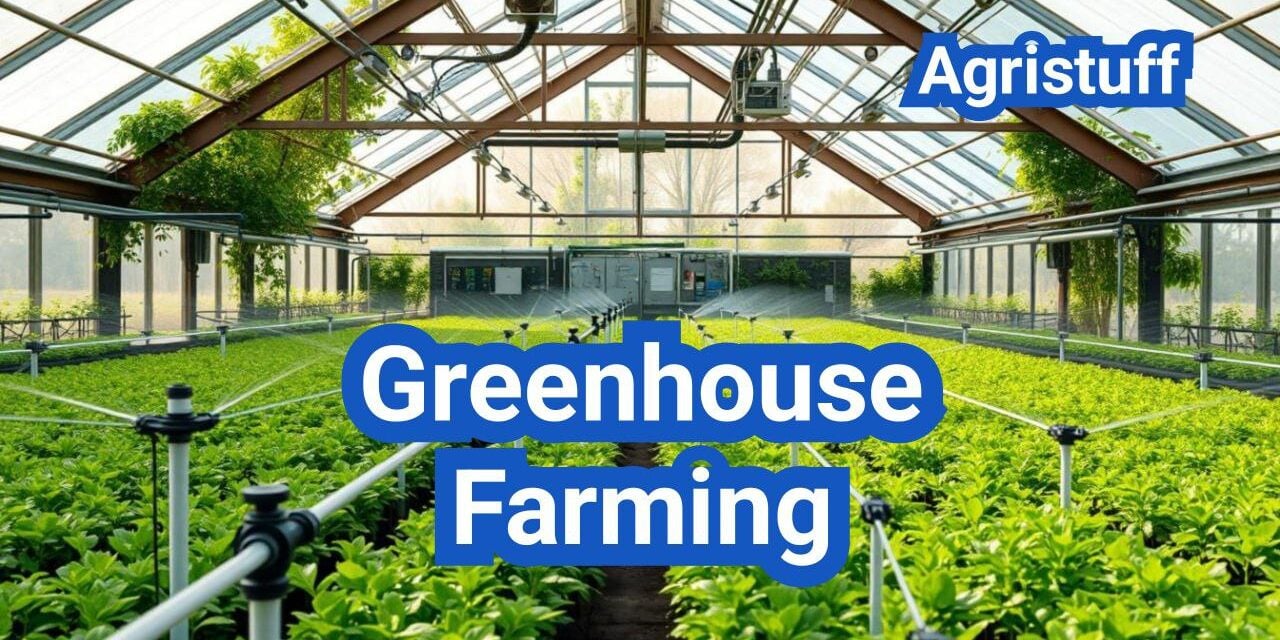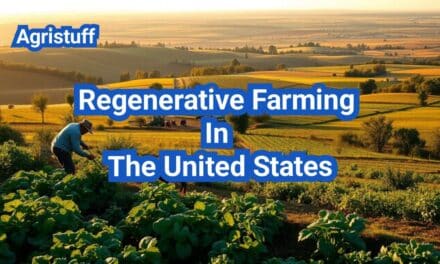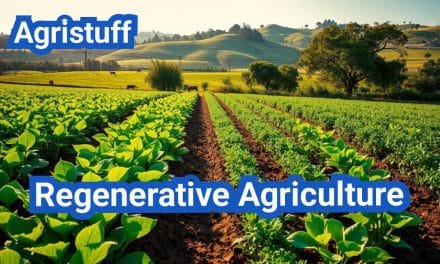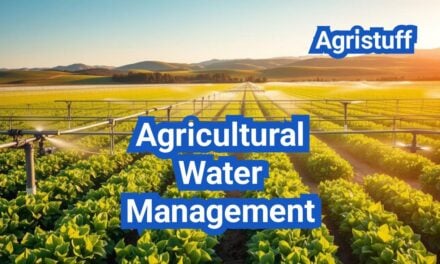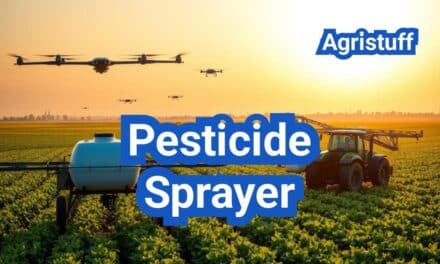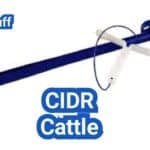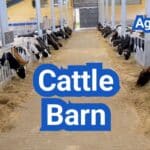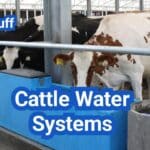Greenhouse farming, a form of controlled environment agriculture (CEA), is revolutionizing the way crops are grown. By providing a controlled environment, it significantly increases yields while reducing water usage, making it an increasingly important method in modern agriculture.
The importance of climate control in greenhouse farming cannot be overstated, as it allows farmers to optimize growing conditions for specific crops. This, combined with strategic cropping plans, enables the maximization of yield economics.
As the global demand for food production rises, understanding the intricacies of greenhouse farming, including its economic benefits, becomes crucial. This article will delve into the specifics of climate control, cropping plans, and yield economics in greenhouse farming.
Key Takeaways
- The role of climate control in optimizing crop yields.
- How cropping plans impact yield economics.
- The economic benefits of controlled environment agriculture.
- Strategies for maximizing yield in greenhouse farming.
- The future of greenhouse farming in global food production.
Understanding Greenhouse Farming and Controlled Environment Agriculture
Greenhouse farming, a cornerstone of controlled environment agriculture (CEA), is revolutionizing the way we grow crops. This method of farming involves creating a controlled environment to optimize plant growth, improve crop yields, and reduce the environmental impact of traditional farming practices.
What Is Greenhouse Farming?
Greenhouse farming refers to the practice of growing plants within a greenhouse, a structure made of transparent or translucent materials like glass or plastic. This setup allows for the control of temperature, humidity, and light, creating an ideal environment for plant growth regardless of the external weather conditions.
Key components of greenhouse farming include climate control systems, irrigation management, and crop selection. By manipulating these factors, farmers can significantly enhance crop productivity and quality.
The Evolution of Controlled Environment Agriculture
Controlled Environment Agriculture (CEA) has evolved significantly over the years, from simple greenhouses to sophisticated facilities equipped with advanced technology. The development of CEA has been driven by the need to increase food production while minimizing environmental impact.
The integration of technologies such as hydroponics, LED lighting, and climate control systems has transformed CEA into a highly efficient and productive farming method. These advancements have enabled farmers to optimize growing conditions for a wide range of crops, from leafy greens to tomatoes and cucumbers.
Key Benefits of Growing in Protected Environments
Growing crops in protected environments like greenhouses offers numerous benefits, including:
- Increased crop yields due to optimized growing conditions
- Reduced water usage through efficient irrigation systems
- Improved crop quality and consistency
- Extended growing seasons, allowing for year-round production
- Reduced environmental impact by minimizing the use of pesticides and other chemicals
By leveraging these advantages, greenhouse farming and CEA are poised to play a crucial role in meeting the world’s future food needs.
Types of Greenhouse Structures for Commercial and Home Use

From traditional glass greenhouses to modern vertical systems, the options for greenhouse farming are diverse and expanding. The choice of greenhouse structure depends on several factors, including climate, available space, budget, and the type of crops to be grown.
Traditional Glass Greenhouses
Traditional glass greenhouses are the most iconic and have been used for centuries. They offer excellent light transmission and can be very durable. “Glass greenhouses provide a classic, timeless look and can be very effective for a wide range of crops,” says a leading greenhouse expert. The main advantages of glass greenhouses include:
- Excellent light transmission
- Durability
- Aesthetic appeal
However, they can be expensive to construct and maintain, especially for large-scale operations.
High Tunnels and Hoop Houses
High tunnels and hoop houses are more affordable alternatives to traditional greenhouses. They are typically made of metal frames covered with plastic or poly film. These structures are:
- Cost-effective
- Easy to construct
- Flexible in design
A notable example is the use of high tunnels in strawberry production, which has become increasingly popular due to its effectiveness in extending the growing season.
Vertical Greenhouse Systems
Vertical greenhouse systems represent a modern approach to greenhouse farming, maximizing space by growing crops in vertically stacked layers. This method is particularly useful in urban areas where space is limited. The benefits include:
- Increased yield per square foot
- Improved resource efficiency
- Potential for integration with urban environments
As vertical farming continues to evolve, we can expect to see more innovative applications in the future.
Selecting the Right Greenhouse Type for Your Needs
When choosing a greenhouse structure, it’s essential to consider your specific needs and constraints. Factors to consider include:
- Climate and weather conditions
- Available space and land cost
- Initial investment and ongoing costs
- Type of crops to be grown
By carefully evaluating these factors, you can select a greenhouse type that meets your needs and enhances your crop production capabilities.
Site Selection and Greenhouse Orientation Fundamentals
The success of a greenhouse operation begins with careful site selection and optimal orientation. Choosing the right location is crucial for maximizing sunlight exposure, minimizing environmental impacts, and ensuring efficient operation.
Evaluating Land Requirements
When evaluating land for a greenhouse, several factors come into play. The site should have:
- Adequate space for the greenhouse structure and potential expansion
- Good drainage to prevent waterlogging
- Stable soil composition to support the weight of the greenhouse
- Minimal risk of flooding or extreme weather conditions
Optimal Orientation for Maximum Light Exposure
The orientation of a greenhouse is critical for capturing sunlight. In the northern hemisphere, greenhouses are typically oriented with their ridge running east-west to maximize southern exposure. This orientation helps in:
- Capturing more sunlight during the winter months
- Reducing shading from the structure itself
- Improving overall light distribution inside the greenhouse
Access to Utilities and Resources
Proximity to essential utilities and resources is another vital consideration. This includes:
- Access to a reliable water supply
- Electricity for heating, cooling, and lighting systems
- Proximity to markets or distribution channels for the produce
By carefully evaluating these factors, greenhouse operators can ensure a solid foundation for their operation, leading to improved efficiency and productivity.
Climate Control Systems in Modern Greenhouse Farming

Advanced climate control technologies are revolutionizing greenhouse farming by providing growers with unprecedented control over their growing environments. These systems are crucial for optimizing crop production, improving yield quality, and reducing energy consumption.
Temperature Management Strategies
Effective temperature management is critical in greenhouse farming. Growers use various strategies to maintain optimal temperatures, including heating systems during colder months and cooling systems during warmer periods. The choice of strategy often depends on the specific crop requirements and local climate conditions.
Some common temperature management techniques include:
- Using insulation materials to reduce heat loss
- Implementing shading systems to prevent overheating
- Employing ventilation systems to circulate air and regulate temperature
Fan and Pad Cooling Systems
Fan and pad cooling systems are a popular method for cooling greenhouses. These systems work by drawing hot air through wet pads, cooling the air before it enters the greenhouse. This method is particularly effective in dry climates where evaporative cooling can significantly reduce temperatures.
The efficiency of fan and pad cooling systems depends on factors such as pad material, fan capacity, and greenhouse design. Proper maintenance is essential to ensure optimal performance.
Root Zone Heating Implementation
Root zone heating involves warming the soil or growing medium to promote healthy root development. This technique can improve crop growth rates and extend the growing season. Common methods include using electric heating cables or hot water pipes placed in the root zone.
Root zone heating can be particularly beneficial for crops that are sensitive to cold temperatures or have high thermal requirements.
CO2 Enrichment Techniques
CO2 enrichment is a technique used to enhance plant growth by increasing the concentration of carbon dioxide in the greenhouse. Plants use CO2 for photosynthesis, and elevated levels can lead to increased growth rates and yields.
CO2 enrichment can be achieved through various methods, including:
| Method | Description | Benefits |
|---|---|---|
| CO2 Generators | Burn fuel to produce CO2 | Effective, can be cost-efficient |
| CO2 Tanks | Store and release pure CO2 | Precise control, easy to use |
| CO2 Sensors | Monitor CO2 levels | Ensure optimal CO2 concentrations |
By implementing these climate control strategies, greenhouse farmers can create optimal growing conditions, improve crop yields, and reduce environmental impact.
Understanding Light Management and Daily Light Integral (DLI)
Understanding and managing light exposure is essential for maximizing yields in controlled environment agriculture. Light is a critical factor that influences photosynthesis, plant growth, and development. Effective light management involves not just providing sufficient light, but also ensuring that the light is delivered in the right spectrum and intensity for the specific crops being grown.
Measuring and Monitoring DLI
Daily Light Integral (DLI) refers to the total amount of photosynthetic active radiation (PAR) received by plants over a 24-hour period. It’s a crucial metric for greenhouse farmers as it directly impacts plant growth and productivity. Measuring DLI involves using sensors that quantify the amount of PAR in moles per square meter per day (mol/m²/d).
Monitoring DLI is essential for optimizing growing conditions. By understanding the DLI, farmers can make informed decisions about supplemental lighting, shading, and other light management strategies. For instance, crops like tomatoes and cucumbers require higher DLI compared to leafy greens.
Table: DLI Requirements for Common Greenhouse Crops
| Crop | DLI Requirement (mol/m²/d) |
|---|---|
| Tomatoes | 20-30 |
| Cucumbers | 25-35 |
| Leafy Greens | 5-15 |
Supplemental Lighting Systems
Supplemental lighting is used to enhance natural light, especially during periods of low sunlight or to meet the specific DLI requirements of crops. LED grow lights are becoming increasingly popular due to their energy efficiency and ability to be tailored to specific spectra.
“The use of LED grow lights has revolutionized the way we approach supplemental lighting in greenhouses. Their flexibility and efficiency make them an ideal choice for a wide range of crops.” – Expert in Controlled Environment Agriculture
Other types of supplemental lighting include High-Intensity Discharge (HID) lamps and fluorescent lighting. The choice of lighting system depends on factors such as the type of crop, energy costs, and the existing infrastructure of the greenhouse.
Optimizing Light for Different Crop Types
Different crops have varying light requirements. Optimizing light involves not just adjusting the intensity, but also the spectrum. For example, blue light promotes vegetative growth, while red light encourages flowering and fruiting.
- Leafy greens and herbs typically require lower light levels and can thrive under LED lights with a blue spectrum.
- Fruiting crops like tomatoes and peppers benefit from higher light intensities and a broader spectrum that includes red light.
By understanding the specific light requirements of different crops, greenhouse farmers can tailor their light management strategies to maximize yields and improve crop quality.
Humidity Control and Vapor Pressure Deficit (VPD) Management

Humidity control and vapor pressure deficit management are critical components of a successful greenhouse operation. Maintaining optimal humidity levels is essential for promoting healthy plant growth, preventing water stress, and maximizing crop yields.
The Science Behind VPD
Vapor pressure deficit (VPD) refers to the difference between the amount of moisture in the air and the amount of moisture that the air can hold when it is saturated. It is a critical factor in determining the rate of transpiration in plants. A higher VPD indicates a greater driving force for water loss from the plant, while a lower VPD suggests a reduced rate of transpiration.
The science behind VPD is rooted in the principles of thermodynamics and the physical properties of water. Understanding VPD is crucial for greenhouse farmers, as it directly impacts plant water stress, growth rates, and overall productivity.
Ideal VPD Ranges for Common Greenhouse Crops
Different crops have varying optimal VPD ranges. For instance, crops like tomatoes and cucumbers generally thrive in a VPD range of 0.8 to 1.2 kPa, while leafy greens such as lettuce may prefer a slightly lower range of 0.5 to 1.0 kPa.
- Tomatoes: 0.8-1.2 kPa
- Cucumbers: 0.8-1.2 kPa
- Lettuce: 0.5-1.0 kPa
- Peppers: 0.7-1.1 kPa
Understanding the ideal VPD range for specific crops allows greenhouse farmers to fine-tune their climate control strategies and optimize growing conditions.
Equipment and Techniques for Humidity Management
Effective humidity management in greenhouses involves a combination of equipment and techniques. Some common methods include using fogging systems, misting systems, and evaporative cooling pads to increase humidity, while ventilation and heating systems can help reduce it.
Advanced climate control systems can integrate various sensors and actuators to maintain optimal humidity levels. These systems can monitor temperature, humidity, and VPD in real-time, making adjustments as necessary to ensure that growing conditions remain within the desired range.
By implementing appropriate humidity control measures and managing VPD effectively, greenhouse farmers can create an optimal growing environment that promotes healthy plant growth and maximizes yields.
Developing Effective Greenhouse Farming Cropping Plans

Greenhouse farming success hinges on developing cropping plans that maximize yield and efficiency. A well-structured cropping plan is essential for optimizing resource use, managing crop cycles, and ensuring a continuous harvest throughout the year.
Seasonal Crop Selection Strategies
Selecting the right crops for different seasons is crucial in greenhouse farming. This involves understanding the specific climate and light conditions of each season and choosing crops that thrive in those conditions.
- Spring Crops: Tomatoes, cucumbers, and peppers are popular choices for spring. They benefit from the increasing light and temperature.
- Summer Crops: Heat-tolerant crops like okra and eggplant do well in the warm summer months.
- Fall Crops: As temperatures cool, crops like lettuce, spinach, and kale become ideal for fall production.
- Winter Crops: In colder climates, cold-hardy crops or those that can be grown under supplemental lighting, such as microgreens, are suitable for winter.
Succession Planting for Continuous Harvest
Succession planting involves staggering crop planting dates to ensure a continuous harvest. This technique helps in managing labor, reducing waste, and maintaining a consistent supply of produce to the market.
“Succession planting is a key strategy in greenhouse farming, allowing growers to maximize space and extend the harvest season.” – Expert in Greenhouse Farming
To implement succession planting effectively:
- Determine the crop’s growth cycle and plan planting dates accordingly.
- Stagger plantings by a specific interval (e.g., weekly or biweekly) to maintain a continuous harvest.
- Monitor crop performance and adjust the planting schedule as needed based on observed growth patterns and market demand.
Intercropping and Companion Planting in Greenhouses
Intercropping and companion planting are strategies used to maximize space and improve crop health. Intercropping involves growing two or more crops together, while companion planting focuses on pairing crops that benefit from each other’s growth.
For example, planting marigolds with tomatoes can help deter nematodes, while basil planted alongside tomatoes is believed to improve flavor.
- Benefits: Improved pest management, enhanced biodiversity, and more efficient use of greenhouse space.
- Considerations: Ensure that companion plants do not compete with the primary crop for resources like light, water, or nutrients.
By incorporating these strategies into a comprehensive cropping plan, greenhouse farmers can optimize their production, reduce environmental impact, and improve profitability.
Irrigation and Fertigation Systems for Greenhouse Production

The success of greenhouse farming operations depends significantly on the implementation of efficient irrigation and fertigation systems. These systems are crucial for delivering the right amount of water and nutrients to crops, directly impacting their health, growth, and productivity.
Designing Efficient Irrigation Systems
Designing an efficient irrigation system for a greenhouse involves several key considerations. First, it’s essential to understand the water requirements of the crops being grown. Different crops have different needs based on their species, growth stage, and environmental conditions.
- Selecting the appropriate irrigation method, such as drip irrigation or ebb-and-flow systems, based on crop type and greenhouse layout.
- Ensuring uniform water distribution to prevent overwatering or underwatering.
- Implementing a system that can be easily automated and monitored.
Efficient irrigation systems not only conserve water but also reduce the risk of water-borne diseases and nutrient leaching. Drip irrigation, for example, delivers water directly to the roots of the plants, minimizing evaporation and runoff.
Creating a Greenhouse Fertigation Schedule
Fertigation, the process of delivering fertilizers through the irrigation system, is a critical component of greenhouse nutrient management. Creating a fertigation schedule involves understanding the nutritional needs of the crops at different growth stages.
- Determine the nutrient requirements of your crops based on their growth stage and variety.
- Select a balanced fertilizer that meets these needs, considering factors like N-P-K ratios.
- Adjust the fertigation schedule according to changes in environmental conditions, such as temperature and light intensity.
A well-planned fertigation schedule ensures that crops receive the necessary nutrients for optimal growth, improving yield and quality. Regular monitoring of crop health and adjustment of the fertigation schedule as needed are crucial for maximizing the benefits of fertigation.
Water Quality Management and Conservation
Water quality management is vital in greenhouse production, as poor water quality can lead to reduced crop yields and increased risk of disease. Strategies for managing water quality include:
- Regular testing for pH, EC, and contaminants.
- Implementing water treatment systems, such as filtration or disinfection, as necessary.
- Using water conservation techniques, like rainwater harvesting, to reduce dependence on external water sources.
Conserving water not only reduces the environmental impact of greenhouse operations but also helps in managing water costs. Water-efficient practices are becoming increasingly important as the greenhouse industry moves towards more sustainable production methods.
Implementing an Integrated Pest Management (IPM) Program

Implementing an Integrated Pest Management (IPM) program is essential for maintaining a balanced ecosystem in greenhouses. IPM involves a holistic approach to managing pests, combining physical, cultural, biological, and chemical controls to minimize harm to people, the environment, and beneficial organisms.
Preventative Pest Control Strategies
Preventative measures are crucial in IPM. These include:
- Regular monitoring of crops for signs of pests or disease
- Use of pest-resistant crop varieties
- Maintaining a clean growing environment, free from weeds and debris
- Implementing quarantine procedures for new plants
Monitoring is a key component of preventative pest control. Regular scouting helps in early detection of pest issues, allowing for timely intervention.
Biological Control Agents for Greenhouses
Biological control agents are a vital part of IPM in greenhouses. These include:
| Biological Control Agent | Target Pest | Effectiveness |
|---|---|---|
| Lady Beetles | Aphids | High |
| Predatory Mites | Spider Mites | High |
| Parasitic Wasps | Whiteflies, Aphids | Medium to High |
Biological control not only reduces the reliance on chemical pesticides but also helps in maintaining a balanced ecosystem within the greenhouse.
Disease Management in Controlled Environments
Disease management is an integral part of IPM. Strategies include:
- Using disease-resistant cultivars
- Implementing cultural practices that reduce disease risk, such as proper spacing and watering techniques
- Applying biological or chemical controls as needed
By integrating these strategies, greenhouse operators can effectively manage diseases and pests, ensuring a healthy and productive crop.
The Economics of Greenhouse Farming in the USA

Understanding the economics of greenhouse farming is crucial for farmers and investors alike in the USA. The greenhouse farming industry has seen significant growth due to its potential for high yields and efficient resource use.
Initial Investment Requirements
The initial investment for setting up a greenhouse farm can be substantial. It includes costs such as land acquisition, greenhouse structure, climate control systems, irrigation systems, and initial crop planting. The cost can vary widely depending on the size of the operation and the technology used. For instance, a basic high tunnel greenhouse might cost between $2 to $5 per square foot, while a more advanced, climate-controlled greenhouse can cost $20 to $50 per square foot or more.
Key components of initial investment include:
- Land preparation and greenhouse structure
- Climate control and irrigation systems
- Initial crop and planting materials
- Technology and automation systems
Operational Cost Breakdown
Operational costs in greenhouse farming include labor, energy, water, fertilizers, and pest control measures. Labor costs can be significant, especially for crops that require manual harvesting. Energy costs are also a major factor, particularly for heating and cooling systems. Efficient management of these resources is crucial for maintaining profitability.
Efficient operational practices can help reduce costs:
- Implementing energy-efficient heating and cooling systems
- Using drip irrigation to conserve water
- Optimizing labor through automation and efficient crop management
Yield Economics and Profit Potential
The yield economics of greenhouse farming can be highly favorable due to the controlled environment, which allows for multiple crop cycles per year. Crops such as tomatoes, cucumbers, and leafy greens are commonly grown and can provide high returns on investment. The profit potential is influenced by factors such as market demand, production costs, and the ability to maintain high-quality crops consistently.
Factors influencing profit potential include:
- Market demand and pricing
- Production efficiency and yield
- Quality of the crop and consistency of supply
Regional Market Opportunities Across the United States
The USA offers diverse regional market opportunities for greenhouse farming. Regions with high population densities, such as the Northeast and California, provide strong markets for fresh produce. Additionally, areas with less favorable outdoor climates can benefit from greenhouse production, allowing for local food production year-round.
Regional advantages include:
- Proximity to large consumer markets
- Potential for year-round production
- Opportunities for niche marketing of specialty crops
Technology Integration in Commercial Greenhouse Farming

The integration of technology in commercial greenhouse farming has revolutionized the way crops are grown and managed. This transformation is largely driven by advancements in automation, environmental control systems, and data analytics.
Automation and Environmental Control Systems
Automation plays a vital role in modern greenhouse farming, enabling growers to control and monitor various environmental factors with precision. Environmental control systems allow for the regulation of temperature, humidity, and light levels, creating optimal conditions for crop growth.
Key features of automation and environmental control systems include:
- Automated climate control
- Precision irrigation systems
- Advanced LED lighting systems
- CO2 supplementation
As noted by experts, “The use of automation in greenhouses not only improves efficiency but also reduces labor costs and enhances crop quality” (
Source: Greenhouse Grower
Data Collection and Analytics for Crop Optimization
Data collection and analytics are crucial for optimizing crop yields and reducing waste in greenhouse farming. By leveraging data from various sources, growers can make informed decisions about crop management.
Some of the key data points collected in greenhouse farming include:
- Temperature and humidity levels
- Soil moisture content
- Light intensity and duration
- CO2 levels
Advanced analytics tools help in analyzing these data points to identify trends and patterns, enabling growers to optimize growing conditions.
Emerging Technologies in CEA
Controlled Environment Agriculture (CEA) is witnessing the emergence of several new technologies that are set to further transform greenhouse farming.
Some of the emerging technologies include:
- Artificial intelligence (AI) for predictive analytics
- Internet of Things (IoT) devices for real-time monitoring
- Vertical farming techniques for increased yield per square foot
- Robotics for automated harvesting and pruning
These technologies are expected to play a significant role in shaping the future of commercial greenhouse farming.
Achieving USDA GAP Certification for Greenhouse Operations

The process of obtaining USDA GAP certification involves several key steps that greenhouse operators must carefully follow to ensure compliance with national food safety standards.
Understanding GAP Requirements
GAP (Good Agricultural Practices) certification is designed to ensure that produce is safe for consumption. To achieve this, greenhouse operators must understand and implement the GAP requirements, which include:
- Proper handling and storage of produce
- Water quality management
- Soil and substrate management
- Worker hygiene practices
Understanding these requirements is the first step towards achieving certification. Operators should familiarize themselves with the USDA’s GAP guidelines and assess their current practices against these standards.
Documentation and Record-Keeping Systems
Effective documentation and record-keeping are crucial for demonstrating compliance with GAP requirements. Greenhouse operators should establish a robust system for:
- Recording water testing results
- Documenting soil and substrate management practices
- Tracking worker training and hygiene practices
- Maintaining records of produce handling and storage
A well-organized record-keeping system not only facilitates the certification process but also helps in identifying areas for improvement in daily operations.
| Record Type | Frequency | Retention Period |
|---|---|---|
| Water Testing Results | Weekly | 2 years |
| Worker Training Records | Upon Training | 3 years |
| Produce Handling Logs | Daily | 1 year |
Preparing for GAP Certification Audits
Preparation is key to successfully passing a GAP certification audit. Greenhouse operators should:
- Conduct internal audits to ensure compliance
- Review and update their record-keeping systems
- Train workers on GAP practices and the importance of compliance
By understanding the requirements, maintaining thorough documentation, and preparing for audits, greenhouse operators can achieve USDA GAP certification, enhancing their credibility and marketability.
The Future of Greenhouse Farming in America
The future of greenhouse farming in America is poised for significant growth, driven by increasing demand for locally grown produce and advancements in controlled environment agriculture (CEA) technology. As the industry continues to evolve, greenhouse farming is likely to play a crucial role in meeting the country’s food production needs.
Greenhouse farming in America is expected to benefit from ongoing research and development in areas such as automation, LED lighting, and climate control systems. These advancements will enable growers to optimize crop yields, reduce energy consumption, and improve resource allocation.
Despite the promising outlook, the industry will need to address challenges related to energy costs, water management, and regulatory compliance. By adopting innovative technologies and best practices, greenhouse farmers in America can capitalize on emerging opportunities and contribute to a more sustainable food system.
As the industry continues to grow, it is likely that we will see increased adoption of CEA technologies and more efficient greenhouse farming practices. This will enable the United States to maintain its position as a leader in agricultural production while minimizing its environmental footprint.
FAQ
What is greenhouse farming?
Greenhouse farming is a method of growing crops in a controlled environment, typically within a structure made of transparent or translucent materials, such as glass or plastic, where climate conditions can be regulated to optimize plant growth.
What are the benefits of greenhouse farming?
Greenhouse farming offers several benefits, including increased crop yields, reduced water usage, improved crop quality, and extended growing seasons, as well as protection from pests and diseases.
What types of greenhouses are available for commercial and home use?
There are various types of greenhouses, including traditional glass greenhouses, high tunnels, hoop houses, and vertical greenhouses, each with its own advantages and disadvantages.
How do I select a suitable site for a greenhouse?
When selecting a site for a greenhouse, consider factors such as land requirements, optimal orientation for maximum light exposure, and access to utilities and resources.
What is Controlled Environment Agriculture (CEA)?
Controlled Environment Agriculture (CEA) refers to the use of technology and controlled environments to optimize crop growth, including greenhouses, indoor agriculture, and vertical farming.
How does climate control work in greenhouse farming?
Climate control in greenhouse farming involves regulating temperature, humidity, and light to create optimal growing conditions, using techniques such as temperature management strategies, fan and pad cooling systems, and CO2 enrichment.
What is Daily Light Integral (DLI) and why is it important?
Daily Light Integral (DLI) measures the total amount of photosynthetically active radiation (PAR) received by plants over a 24-hour period, and is crucial for optimizing crop growth and development.
How can I manage humidity and Vapor Pressure Deficit (VPD) in a greenhouse?
Managing humidity and VPD involves understanding the science behind VPD, maintaining ideal VPD ranges for specific crops, and using equipment and techniques such as humidification and dehumidification systems.
What is an Integrated Pest Management (IPM) program?
An Integrated Pest Management (IPM) program is a holistic approach to managing pests and diseases in greenhouses, involving preventative strategies, biological control agents, and disease management techniques.
How can I achieve USDA GAP certification for my greenhouse operation?
To achieve USDA GAP certification, you need to understand GAP requirements, implement documentation and record-keeping systems, and prepare for GAP certification audits.
What are the initial investment requirements for starting a greenhouse farm?
Initial investment requirements for starting a greenhouse farm vary depending on factors such as the size and type of greenhouse, equipment, and technology used.
What are the emerging technologies in Controlled Environment Agriculture (CEA)?
Emerging technologies in CEA include automation and environmental control systems, data collection and analytics, and innovative growing systems such as vertical farming and hydroponics.
How can technology integration improve commercial greenhouse farming?
Technology integration can improve commercial greenhouse farming by optimizing crop growth, reducing labor costs, and improving efficiency through automation, data analysis, and precision agriculture techniques.
Conclusion of: Greenhouse Farming
What is greenhouse farming (and why it matters now)?
Greenhouse farming is the practice of growing crops in enclosed structures where light, temperature, humidity, and water are actively managed to stabilize yields and quality across seasons—a major advantage for U.S. growers facing weather volatility. By bringing crop-growing decisions indoors, greenhouse farming becomes part of Controlled Environment Agriculture (CEA), letting you tune inputs to market targets instead of the weather’s mood swings. Cornell CEA overview
Season extension and structure choices
Greenhouse farming ranges from simple unheated “high tunnels” to fully heated and cooled glass or poly houses; both extend the season, but high tunnels are lower-cost and excel at early/late production, while heated houses unlock year-round supply where demand justifies energy spend. Greenhouse farming’s protection from rainfall also enables precise fertigation and improved disease management compared to open field. USDA NRCS: High Tunnel System
Climate control basics: temperature, humidity, and VPD
Greenhouse farming lives or dies by climate balance: temperature sets metabolic rate, humidity governs transpiration, and the combo is summarized by vapor-pressure deficit (VPD). For vegetative growth in greenhouse farming of fruiting vegetables, aim for a moderate VPD to keep leaves dry and transpiration steady, while propagation prefers gentler VPD to avoid wilting. MSU Extension: VPD for greenhouse growers
Light management: DLI is your north star
Greenhouse farming should be planned around Daily Light Integral (DLI)—the moles of photosynthetically active photons your crop receives per day—which drives yield, flavor, and morphology. Estimate indoor DLI from outdoor maps and cover transmission, then decide if supplemental LEDs or de-shading are justified in your greenhouse farming plan. MSU: DLI defined
Heating strategies and energy priorities
In most temperate U.S. regions, greenhouse farming’s biggest energy bill is winter heating, so insulation, air-tightness, thermal curtains, and fuel choice are ROI leaders. Right-size heaters using heat-loss calculations, then watch cents per BTU for propane vs. natural gas vs. biomass as markets shift year to year in greenhouse farming. Farm Energy: Greenhouse Energy Efficiency
Root-zone heating: warm the roots, save the fuel
Greenhouse farming benefits from root-zone heating mats or hydronic pipes that hold root temperatures at crop optimums; that lets you run cooler air by 5–10°F, cutting fuel while maintaining growth. This strategy often gives the fastest early-spring returns for greenhouse farming. Farm Energy: Root-Zone Heating
Ventilation, dehumidification, and air movement
Greenhouse farming depends on steady air exchange and movement to remove latent heat, sweep humidity off leaf surfaces, and keep CO₂ uniform. Use natural venting when weather allows; switch to mechanical fans when differential pressures fall short, and add HAF fans to even out microclimates in greenhouse farming. UF/IFAS: Greenhouse Ventilation
Cooling: fan-and-pad systems done right
When summers spike, greenhouse farming often turns to evaporative fan-and-pad systems; correct sizing and continuous pads matter because “gaps” create downstream hot zones and yield loss. Match exhaust fan capacity and pad face velocity to house dimensions for efficient greenhouse farming. UF/IFAS: Fan & Pad Cooling
CO₂ supplementation for yield
Photosynthesis runs on carbon, and greenhouse farming can economically enrich daytime CO₂ to ~700–1,000 ppm when vents are closed and light is strong, especially for C₃ crops like tomatoes, lettuce, and cucumbers. Always pair enrichment with monitoring and a ventilation plan in greenhouse farming. OSU Extension: CO₂ Supplementation
Sensors, controls, and data logging
Modern greenhouse farming leans on sensors (temp/RH, PAR/DLI, CO₂, substrate EC/pH) and simple automations (VPD-based venting, thermal screens, irrigation triggers). Start with data loggers and alarms; scale to climate computers as acreage and crop value justify in greenhouse farming. GLASE: Climate Control Short Course
Irrigation & fertigation fundamentals
Because it’s precise, greenhouse farming typically uses drip or micro irrigation for soil or substrate production and full fertigation for hydroponics. Deliver small, frequent pulses to match evapotranspiration and keep root zones oxygenated, and document recipes for consistent greenhouse farming outcomes. Penn State Extension: Drip Irrigation
pH and EC: the two numbers you must know
Greenhouse farming quality hinges on root-zone pH (nutrient availability) and electrical conductivity (total salts). Test substrate solution weekly; if EC is normal but leaves yellow, correct pH before adding more fertilizer in greenhouse farming systems. UMass Extension: Managing pH & EC
Soilless & hydroponic options
Many greenhouse farming operations migrate into soilless systems to standardize media and automate nutrition. Rockwool, coco coir, and peat mixes each change water/air balance and fertigation strategy—pick based on crop vigor and labor in greenhouse farming. UF/IFAS: Soilless Culture for Greenhouse Vegetables
Crop selection by season and structure
In high tunnels (unheated), greenhouse farming focuses on cool-season greens in fall/winter and warm-season crops (tomato, cucumber, pepper) as days lengthen; heated houses widen the menu, but economics should dictate the crop calendar. Reference regional guidance to time transplants and harvest windows in greenhouse farming. ATTRA: High Tunnel Vegetable Production
Succession planting and cropping plans
Greenhouse farming achieves steady revenue by staggering sowings and rotating plant families to break pest cycles. Use yield tables and your own records to adjust spacing, DLI targets, and harvest cadence—especially for salad mixes and basil—in greenhouse farming. UMN Extension: Succession Planting
Soil health in protected culture
Even in tunnels, greenhouse farming benefits from winter cover crops and compost additions to rebuild tilth and buffer nutrients—crucial where rain no longer leaches salts. Off-season covers in high tunnels add organic matter and help manage nutrient carryover in greenhouse farming. Cornell High Tunnels: Resources
IPM: prevention first
Sanitation, scouting, thresholds, and compatible chemistries sit at the heart of greenhouse farming IPM. Keep weeds out, quarantine new plant material, and standardize sticky-card counts and leaf inspections so interventions are data-driven in greenhouse farming. UC ANR: What is IPM?
Biocontrols and compatible chemistries
For year-round greenhouse farming, biocontrols (e.g., Encarsia for whiteflies) work best when released early and supported by compatible pesticides and climate settings that favor beneficials. Train staff and keep a biocontrol log so timing and rates improve each greenhouse farming cycle. Penn State: Greenhouse IPM with Biocontrols
Food safety & compliance (FSMA, GAP)
Because leafy greens and tomatoes are often eaten fresh, greenhouse farming must meet the FDA’s Produce Safety Rule for ag water and sanitation; recent updates emphasize systems-based pre-harvest water assessments rather than fixed microbial criteria. Many buyers also require USDA GAP audits for greenhouse farming operations. FDA: Pre-Harvest Agricultural Water Rule
Cost structure: where the dollars go
Greenhouse farming budgets split into capital (structure, coverings, benches, climate gear) and operating (labor, energy, inputs, maintenance). Expect labor to stay significant even in automated houses; energy and substrates move with fuel and supply markets, so model sensitivity bands around those in greenhouse farming. Penn State: Greenhouse Cost Accounting
Sample budgets and benchmarks
To ground your plan, greenhouse farming can reference public enterprise budgets and production guides for tomatoes and other crops. Use these to estimate labor hours, planting density, and cash-flow timing for lenders and seasonal hiring in greenhouse farming. MSU Extension: Greenhouse Tomato Production
Funding and incentives
To de-risk entry, greenhouse farming often starts with an NRCS EQIP high-tunnel contract that offsets a portion of structure cost in exchange for conservation practices and record-keeping. Contact your county USDA Service Center to confirm eligibility for greenhouse farming projects. USDA NRCS: EQIP High Tunnel Initiative
Pricing, channels, and payback thinking
Direct-to-consumer and CSA channels can support premium pricing for winter greens and early tomatoes; wholesale prefers consistent volumes. For greenhouse farming paybacks, stress-test with ±20% on price and ±30% on energy, then plan contingency crops (e.g., greens/basil) if a tomato cycle underperforms so cashflow isn’t hostage to one crop. Cornell: Budgets & Spreadsheets
A practical 90-day starter plan
Week 0–2: finalize structure sealing and shade/vent controls; set up VPD-based alerts. Week 2–4: map DLI and irrigation zones, calibrate pH/EC meters. Week 4–8: launch greens/basil succession while grafted tomato seedlings harden. Week 8–12: deploy biocontrols, tighten scout logs, and apply dry-down strategy between irrigations—building greenhouse farming discipline before high-value crops hit full production. Cornell: Integrated Crop & Pest Management Guides
Tomato-specific notes (because everyone asks)
For indeterminate tomatoes, greenhouse farming favors high-wire training (one or two leaders), regular leaf pruning for airflow, and pollination aids (vibration or bumblebees where permitted). Maintain moderate VPD, enrich CO₂ on bright days, and watch leachate EC to avoid tip burn and blossom end rot in greenhouse farming. NC State Extension: Commercial Greenhouse Tomato Production
Leafy greens & herbs: turning fast cycles into steady cash
Greens love cool, even climates; in shoulder seasons, greenhouse farming with tunnels can outcompete field crops by harvesting through mild frosts with row covers and careful venting. Rotate families and match sowing cadence to sales so beds don’t age out in greenhouse farming. ATTRA: High Tunnel Leafy Greens
Lighting decisions without regret
If DLI is consistently below crop targets in winter, greenhouse farming can add LEDs; run a trial bay first, calculating dollars per mole and dollars per pound of yield boost to ensure payback. Weigh spectrum choices alongside supplier support and local utility rebates in greenhouse farming. MSU: U.S. DLI Maps
Maintenance keeps margins
Filters, vents, fans, and pad systems need schedules; greenhouse farming loses money fastest to clogged pads, broken thermostats, and leaky covers. Document preventive-maintenance intervals and keep spares for critical components in greenhouse farming. UF/IFAS: Maintenance of Greenhouse Systems
Final thought
Greenhouse farming succeeds when you treat climate, light, water, and labor as one system—and when your crop plan matches your market. Start with the simplest tech that achieves specifications, log everything, and iterate as your greenhouse farming metrics improve. FAO: Good Practices for Greenhouse Vegetables
Sources & References
- Cornell University CEA
- MSU: Daily Light Integral (DLI)
- Farm Energy: Greenhouse Energy Efficiency
- UF/IFAS: Greenhouse Ventilation
- OSU Extension: CO₂ in Greenhouses
- GLASE: Climate Control
- Penn State Extension: Drip Irrigation
- Cornell: High Tunnel Resources
- UC ANR: What is IPM?
- Penn State: IPM & Biocontrols
- FDA: Pre-Harvest Agricultural Water
- USDA NRCS: EQIP High Tunnel Initiative
- Cornell: Budgets & Spreadsheets
- MSU: DLI Maps
- UF/IFAS: Maintenance of Greenhouse Systems
- FAO: Good Practices for Greenhouse Vegetables

